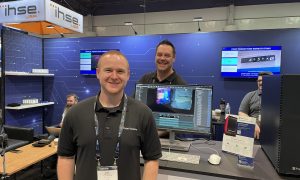NAB 2022 Perspectives: Puget Systems' Matt Bach and Eric Brown on Optimizing Virtualized Production for Professional Franchises
The past two years has both prioritized and accelerated the maturation of numerous production technologies, but nothing has become more prevalent and important than virtualized production. With remote editors across the nation or providing opportunities to work outside of the brick-and-mortar control room, content creators and production crews have learned to work with more efficiency and collaboration. One company that is immersed in supplying these reliable resources is Puget Systems.
Founded in 2000, the company is helping game-day personnel and creatives accomplish their jobs away from the stadium or arena. Some of these clients include the Baltimore Ravens, Arizona Cardinals, Cleveland Browns, Houston Texans, New York Jets, and Atlanta Falcons’ Mercedes-Benz Stadium in the NFL, the Houston Rockets and Portland Trail Blazers in the NBA, the Carolina Hurricanes, Vegas Golden Knights, and New York Islanders in the NHL, the Chicago Cubs in MLB, and ROOT SPORTS Northwest on the RSN front.
At NAB 2022, Senior Hardware Analyst Matt Bach and Marketing Manager Eric Brown highlighted their solutions in partnership with various vendors, how the pandemic affected their work, how they assist professional franchises, and what they want to achieve by the end of 2022.

Puget Systems Marketing Manager Eric Brown poses at Booth N6616 in the North Hall.
What are some top of mind solutions and products being shown this year?
Bach: We’re showing a lot of virtual production. We’re partnering with Vū Studios, so they’re using our systems with Epic Games’ Unreal Engine. Video editing and motion graphics are always our bread and butter as well, so we also have systems running with Blackmagic Design’s DaVinci Resolve, Adobe Premiere, and Adobe After Effects. Those are really the core things that make up what our sports clients work with.
Bach: Before the pandemic, everyone was working in their offices with standardized machines, but after the pandemic, a lot of people were working from home. At first, individuals got away with working off of their laptops, but when they realized how long the pandemic, franchises began working from home on more efficient machines. The computer is the exact same on the hardware side, but we were there to help people get set up with a Remote Desktop. Personally, I hope [remote work] is here to stay because it’s been wonderful, for productivity. I think a hybrid workflow where the prep and setup work can be done comfortably at home, and when you need to do all of your collaboration for the live production, you go into the office.How are your working relationships with sports clients?
Brown: Our business focuses on freelancers or contractors that worked for larger studios at the beginning of the pandemic, but over the past two to three years, we’ve started to expand our focus to include full production studios that create motion graphics and editing. Teams in the NHL are using our systems actually for in-stadium graphics and motion graphics used for their on-ice projections. We also have systems for teams in the NBA, MLB, and NFL as well. These examples fit perfectly with our focus because they’re using applications that we’ve spent a ton of time figuring out what hardware makes most sense for those workflows.
How do you continue to help these clubs throughout their respective seasons?
Brown: We’re not trying to sell general purpose systems. When it comes to digital media teams that work for professional organizations, they’re always trying to push the boundaries of what they’re doing. They want to increases their fan engagement opportunities within the stadium. Since we understand their vision, we try to provide systems in places where we can solve a problem that they may have.
What are some goals or aspirations for the rest of 2022?
Brown: Building off of our partnership with Vū Studios, the whole goal is to create a level of standardization for virtual production computer hardware because it’s the Wild West right now. What we want to do is create standardization, so teams that are trying to do a large-scale project with this resolution and with this many pixels know what hardware they need to succeed. That way, it takes that work off of their plates because it’s already enough work to put those LED elements together.
This interview has been edited for length and clarity.
